Ed is a ten year old son of a friend. He loves to draw and paint. Recently, he completed a four week block of weekly drawing lessons with me. He already has very good drawing skills; largely due to his keen observational skills. *More of Ed’s lovely drawings, and my lesson notes a little further along.
Some thoughts on Drawing
A vital key in learning to draw anything, is to draw from looking closely at your subject matter: to draw well – so as to gain a likeness – is to “see” well. This is how I learnt to draw – which I, Ed and others somehow cottoned on to as a child.
Therefore when I teach drawing, I think it is of great importance, to help people to really “see”, so they can draw: the lines, shapes, tones….of their subject matter.
Drawing from imagination is also important, yet unfortunately, has often become the main or only focus in modern art teaching trends.
Children from 8 and 9 years old onwards, often want to draw in a more realistic manner; and when helped to draw from “seeing”, many discover they can do this. I did some practical research into these areas, during my Art and English (high school) teaching, by taking a group of primary school students, through some observational drawing classes.
It was a joy to see the expression on children’s faces as they drew: toy cars, toy models of animals, their favourite stuffed toys….an so on. Many were delighted and surprised they could draw in this way. Their age was a helpful factor, as by the time they enter high school – in those fun teen years 🙂 – many decide they can’t draw, and it’s difficult (though not impossible) to convince them otherwise!
As well as my own personal experience, my interest in these areas, was sparked by reading, Betty Edward’s book,”Drawing on the Right Side of the Brain”.
These areas of right and left brain hemispheres and their specific functions, and in particular, theories on how they may relate to the ability to draw, or to “see” in order to draw, have been well researched in recent times.
You may already be familiar with these theories. I think they have helped to create a trend back to the teaching of the traditional skills, involved in drawing from direct observation. Here are some more relevant links you may find interesting.
Springer and Deutsch: “Right Brain, Left Brain”
Donald H Taylor: “Modern myths of learning: The creative right brain”.
Ed’s Drawing Sessions
Most of the following notes here are from a sheet I wrote up for Ed, which I gave to him at the end of the four weeks, to recap his drawing travels. It also includes some of the following drawings
*There is more information under each of his drawings.
Along the way there was time allowed for plenty of discussion. I also did demonstration drawings and sometimes we used our iPads to extend an exercise. He mostly drew with a Hb graphite pencil on paper.
To begin I placed a branch of gum-leaves into a glass jar and asked Ed to do 3 x 3 min drawings…and to work as quickly as possible. The drawing above, is one of them – unfortunately, I didn’t get to scan them all.
I’ve used this exercise with others, and often by the third drawing there is a quite noticeable improvement in the drawing: a lighter touch, a more fluid line and a better likeness to the subject matter.
Perhaps, drawing quickly, encourages a right brain type of thinking, which is presumed to be a factor in learning to draw.
We looked at:
- the importance of looking 90% of the time at the subject matter and 10% at the paper;
- how to use light pencil lines to find the edges of the subject matter to depict the shape;
- using light and dark lines; and
- thick and thin lines.

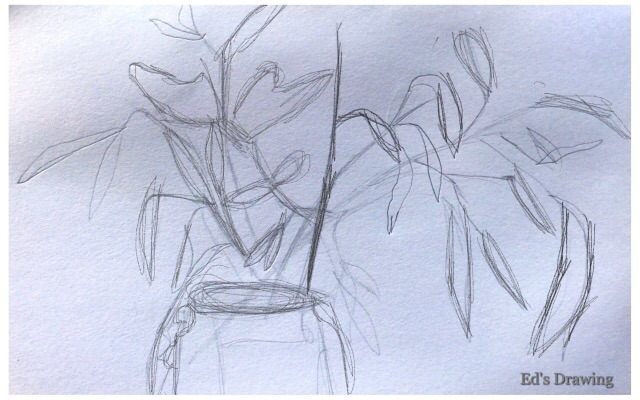
Looking at an individual leaf.

Ed went out and picked some more leaves and found one with an interesting marking on one edge. He really focused deeply on it and did a lovely detailed drawing.
Also looked at using tone on and under the leaf to create its shape.
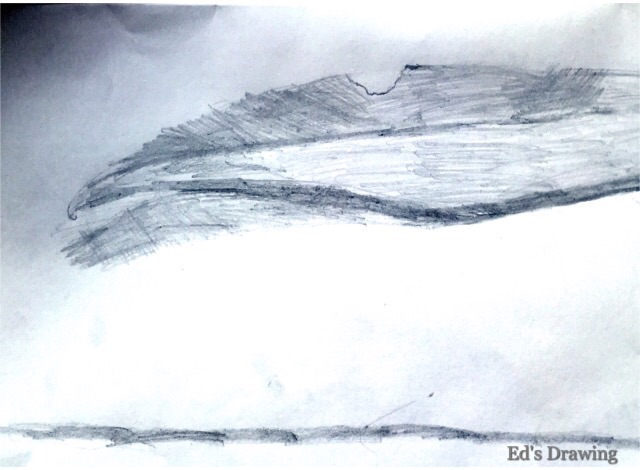
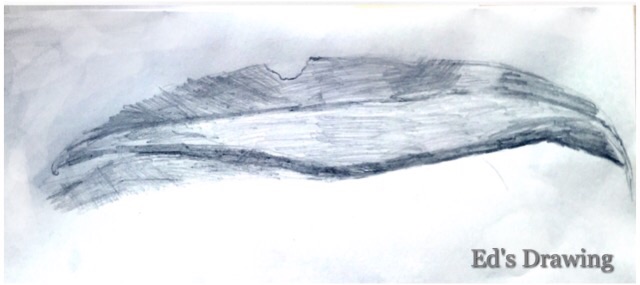
We considered some compositional elements.
- Focal point(s), areas.
- How the picture space around the subject matter helps the overall composition; and
how if you subtract or add a visual element, it can add or detract from the composition – and whether doing this changes, weakens or strengthens the focal point of the drawing. - Looked at how the picture space boundaries and the shapes (negative space) around the subject matter, effect the overall composition.
- The final arrangement of visual elements (“language”) of our drawing within our picture space; it’s overall composition…is part “happy accident” and a lot to do with “conscious” decision making along the way. This happens albeit using different elements in: sculpture, writing…. dance, music…: the latter two have a time-space element as well.
- And how colour can be used to emphasize a focal point.
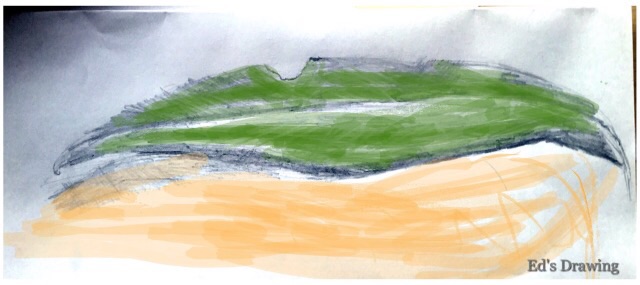
A few times we used the iPad to scan in one of his drawings, (as with the one above) and cropped it in different ways, while we discussed compositional factors. Also, some were printed, and Ed added more tone and/or line work to them.
The “Pro Scanner” app is very handy; great for capturing details. Below are Ed’s drawings of an apple. A couple of prints were made of one of them and he painted them with his watercolours. Ed has a great collection of art materials. *My scanning skills have improved in the last few months since doing these scans!
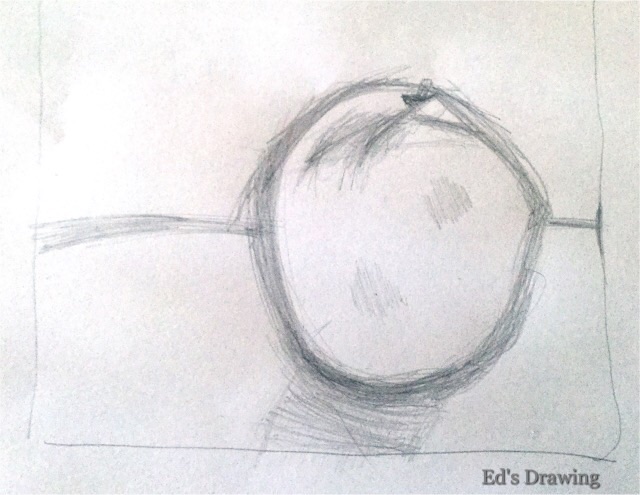
Considered how: the horizon line, the placement of a simple line, behind the subject matter makes it appear as if it sits on a surface – rather than floats.
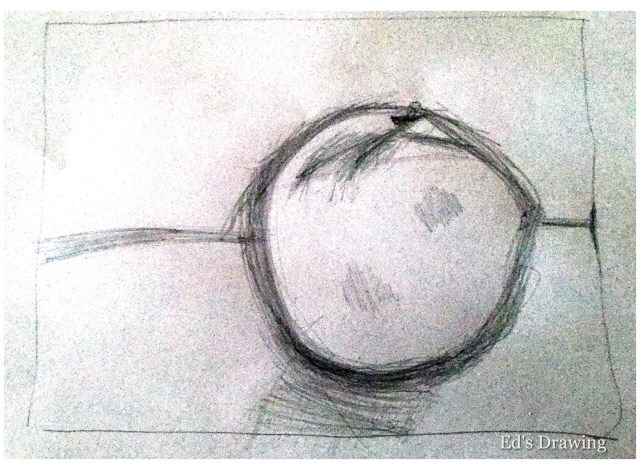
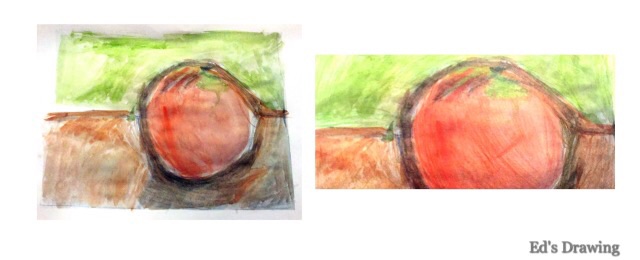
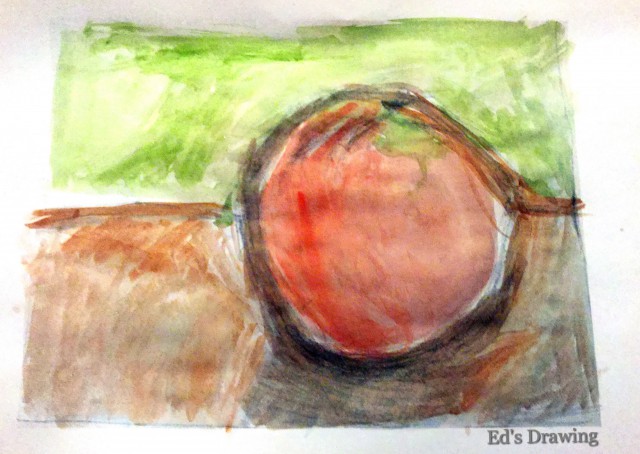
Conclusion
Ed was and is enthusiastic to learn all he can about drawing and painting. I really enjoyed these art travels with Ed. He seemed to have a lot of fun, too. If he continues to learn and practice – which is so important in learning any skill – he’s sure to go a long way with his art. I wish him all the best.
Thanks Ed, for letting me share your wonderful drawings here on my blog.
As I’ve said earlier, drawing from the imagination is important: doing doodles, playing with colours, creating imaginary scenes – all have a part in a well rounded drawing experience. *I’ve seen some beautiful Zentangles; an art form becoming quite popular.
However, I do think, the drawing skills learnt as we look and “see” the wonderful world around us, aside from being a common (and logical!) desire for many; can inform and enrich our ventures into this more whimsical type of drawing.
This has certainly been my experience.
Some people have a flair, perhaps a little of that illusive thing called “talent”. However, as I mention elsewhere in a post, I believe to a large extent –
drawing is a learnable skill.
I hope if you don’t draw yet, you will find encouragement from this post, to give it a go.
Whether on: paper, canvas, iPad…any touch screen device, back of a newsletter, on the corner of a paper napkin…..or just about anywhere! 🙂
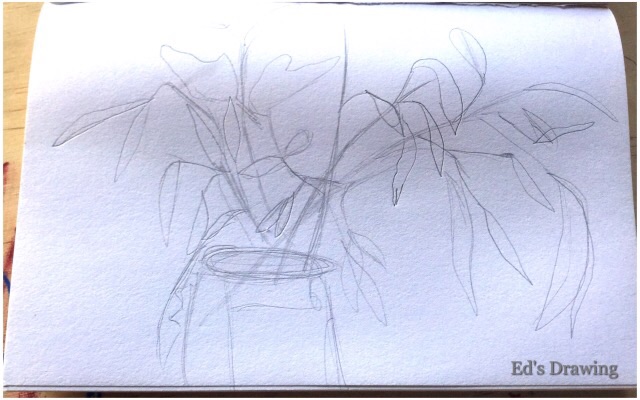






Ed creates beautiful lines and interesting shapes already at an early age. Excellent drawings
LikeLiked by 1 person
Yes, already pretty good at drawing before the lessons! 🙂
LikeLike
Great stuff – how wonderful to be given the chance to contribute to a young person’s art education, and watch how their horizons widen a result. 🙂
LikeLiked by 1 person
Thank you, Rebecca…it was fun, and he was a keen student!
LikeLiked by 1 person
That was a great way to spend some time together. Currently doing ditto with granddaughter, 7, each time we meet. Isn’t it fun to see them make such strides!
LikeLiked by 1 person
Sure is! I love to see kids and adults drawing. I certainly encouraged my four sons to draw and paint as they were growing up and always lots of art materials at home. 🙂
LikeLike
Thanks for sharing this really interesting experience. I was particularly taken by your observation about the emphasis on drawing from the imagination. I hadn’t thought about that before and I think you’re right about spending time more on drawing real things.
LikeLiked by 1 person
Thank you Leonie for your comment. Glad you found it interesting. 🙂
LikeLike
Thanks for this post! Looks like a promising student! Great job with him!
LikeLiked by 1 person
Thanks Laura! 🙂
LikeLiked by 1 person
Great post. I love to see the changes in the drawings.
LikeLiked by 1 person
Thank you. 🙂
LikeLike
Ed is fortunate to engage in such an apprenticeship. Thank you for sharing this and for creating an opportunity for me to join Ed on his journey under your graceful guidance.
LikeLiked by 1 person
Thank you Paul, for your lovely comment! 🙂
LikeLike
What a great opportunity you have given this child! I love working with children, they are so curious and open to learning, this is wonderful!
LikeLiked by 1 person
Thank you! Ed was a pleasure to help with his drawing. I agree, kids can be so positive when it comes to learning most things! 🙂
LikeLiked by 1 person
….it is so wonderful you are encouraging this budding artist because it is so obvious he has gifts–many of them, and honing the talent is crucial, which thankfully you are doing for him. It is so wonderful to see this. Thank you for the detailed posing.
LikeLiked by 1 person
Thank you! He was enthusiastic and keen to learn. It was a pleasure to help him with his art. 🙂
LikeLike
I really enjoyed this! My niece is getting into drawing and I’d love to sit down and teach her but I don’t know where to start as she is only 8 but this gave me ideas 😉 thank you!
LikeLiked by 1 person
Thank you Cam! Glad to be of help. Lovely to see you about again… hope to see another one of your great artworks coming through my reader soon. Have missed seeing them, and reading your often cheerful posts. All the best, Janette. 🙂
LikeLiked by 1 person
Awe thank you so much you are so sweet!! There may be a post down the line of me using your guidance to teach my niece 😂 lol
LikeLiked by 1 person
I thoroughly enjoyed this post and Ed’s drawings. I taught 4th grade for 10 yrs and agree with what you said about the desire by that age group to draw realistically. We used drawing in math, science, reading, and writing as much as it’s used in art classes. What fun for the kids to learn how to really see what they’re looking at.
LikeLiked by 1 person
Thank you Barb! How wonderful you used art in all subject areas – just how it should be! 🙂
LikeLike
Janette, I agree that anyone can be taught to draw. Ed seems to have a natural ability as you do. You’ve brought back fond memories of working through a drawing lesson book with my three children. Art is good for the heart.
Blessings ~ Wendy
LikeLiked by 1 person
Thank you Wendy. I agree, “art is good for the heart”. Lovely words. It’s great that you gave your children art lessons. I love your artwork and poems on your blog, “The Sketchy Poet”.
There was always lots of arty adventures in our household of four sons, too. They’re young men now! Sometimes it feels as if time flies by. All the best, Janette. 🙂
LikeLiked by 1 person
Janette, I learned as much as they did. When my oldest son told me, one day, that his brother now draws better than I do, I knew we’d done a good thing. 😉
LikeLiked by 1 person
Loved this post. I thought that Ed’s drawings and your thoughts and conclusions were right on!
LikeLiked by 1 person
What a lovely comment! Thank you Mary. Have a great day. ~ Janette. 🙂
LikeLiked by 1 person
Hey Janette – Thanks for posting your experience with Ed. Really enjoyed reading it. Agree drawing can be learned by anyone who is motivated to learn – and it sure helps when there is a teacher as thoughtful and committed as you are. Integrating technology into your instruction – what a brilliant way to engage a young learner today. You are a great teacher! – Tom
LikeLiked by 1 person
Thank you Tom! A lovely comment; and from such fine artist, as yourself! Have a great day. ~ Janette. 🙂
LikeLike
Thank you for encouraging Ed in the proper way. So many teachers force students to see the world as they see it. Allowing a student to “see” on his own is vital to his actual learning. Remember, the sky is not always blue.
LikeLiked by 1 person
Thank you Steve. Yes, sometimes teachers can lead a student away from “seeing”! I haven’t painted a lot of skies….though I know what you mean. 🙂 Looking forward to seeing your future posts. ~ Janette
LikeLiked by 1 person